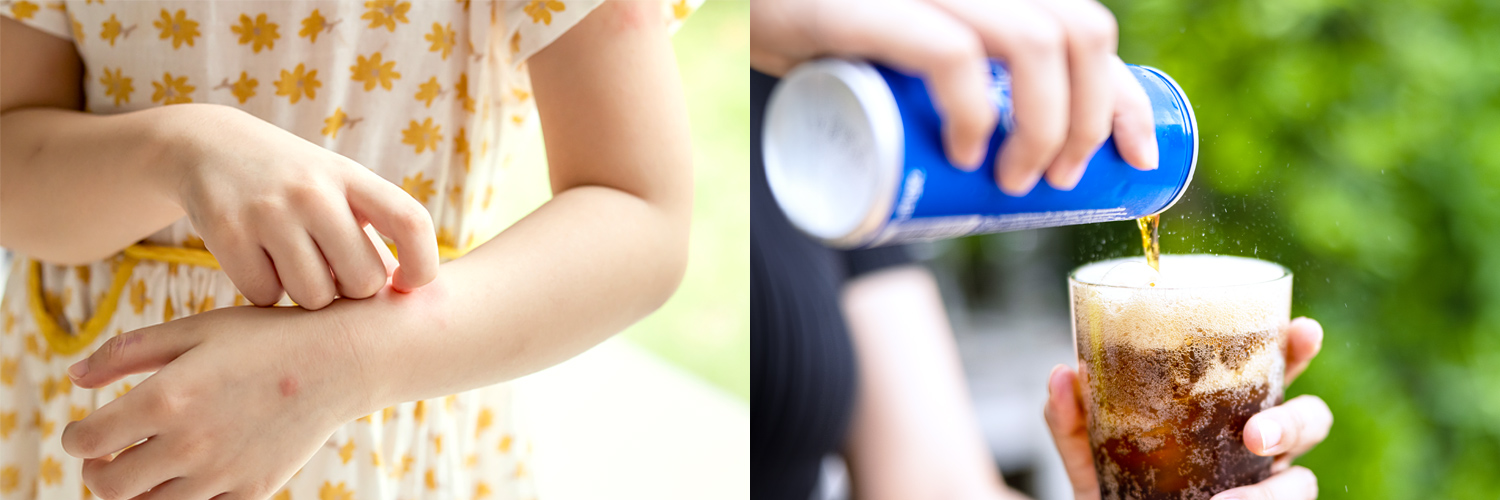
In summer, Ms. Stevens goes to the beach. She is dazzled with sunlight and sweat rolls down her face, but the blue sea and the sandy beach in front of her eyes is so refreshing. She gets her feet wet in the waves and feels happy like a little child at the cool waves hitting her ankles. It hurts a little when she steps on a shell, but a little scratch doesn’t bother her. She can enjoy all these, thanks to skin’s various functions.
Skin, the largest organ of the human body
Skin is the largest and most visible organ in our body. When spread out, its width is about 1.5–2 m2 [16–21 ft2] and it weighs for about 8% of the body weight. There are about 3 million cells, 100 glands, 15 sebaceous glands, and about one-meter-long capillary vessels in nail-sized skin of 1 cm2. Skin is usually regarded as a cover that surrounds the body, but it is actually an important body organ that can be fatal when more than a third of it is lost from burns or other accidents.

Skin is composed of epidermis, dermis, and subcutaneous fat layer starting from the outside. The stratum corneum on the outer surface of the epidermis which is durable and waterproof protects the body from the outside, and it prevents skin from going dry by keeping moisture inside skin from evaporating. The stratum corneum is firmly formed with layers of corneocytes with lipid filling in the gap just like bricks and cement.
Below the epidermis, there is a thick, dense connective tissue called dermis. In the dermis, blood vessels supplying oxygen and nutrients to skin cells, nerve nets spreading like spider webs, numerous sweat glands, follicles producing hair, etc. are all tangled together, carrying out their respective tasks. While the epidermis protects skin at the forefront, the dermis keeps skin healthy and serves to communicate and regulate information about the external environment.
Below the dermis is a subcutaneous fat layer where a lot of fat is. It is generally more developed in women than in men. Besides the role of accumulating fat to generate energy, it also protects the body from the cold and absorbs external shocks, which is why it is easier for people with lower subcutaneous fat layers to break their bones when fallen.
It is a remarkable fact that epidermal cells are filled with new ones through one’s entire life. The lifespan of epidermal cells is 28 days. When the cells made in the epidermis move up to the stratum corneum and then come off like dandruff, that’s their one lifespan. By the age of 70, skin is replaced about 850 times. Like this, the human body changes into new clothes frequently at the right time.
Although skin is constantly replaced, it is the part that suffers more than any other organs in the body. It is scratched, pricked, and hit. However, there is no need to worry because skin has a good sewing machine. When skin gets injured, platelets and immune cells are activated, temporarily filling up the wound, causing an inflammatory reaction to remove bacteria and foreign substances. The fibroblasts that synthesize collagen migrate to the wound and produce connective tissue which connects the gaps in the skin. In this connective tissue, nerve and capillary blood vessels are also elaborately restored.
Skin’s function I: sensation
It’s itchy when you have a bug bite. It aches when you fall and your knee is skinned. Your face turns red when you’re embarrassed, and you break out into a cold sweat when you get nervous. We feel these emotions with our skin and express them with it. Not only does skin play the role of a shield to protect the body from the outside, but it also gets involved in our everyday life and emotional expressions.

It’s possible because of the large distribution of sensory nerve branches and endothelial receptors of the nerves in skin. Sensory receptors include temperature receptors that sense warmth and cold, mechanical receptors that sense pressure or vibration, and pain receptors that transmit pain. For example, when you take out a cool beverage can from a refrigerator, the mechanical receptors feel the smoothness of the can, and the temperature receptors feel the coldness.
Sensory receptors specialized to each sense are also responsible for protecting the body by transmitting information about the external environment to the central nervous system. The temperature receptor which senses the coldness is mainly concentrated in the nose and the ear. It detects the external temperature first, protects the human body from the cold. The pain receptor which allows the human body to feel the pain plays the role of an alarm so that the body can quickly respond to a dangerous situation.
At the fingertips, the Meissner’s corpuscles are distributed the most, so that the various tactile senses are more precisely distinguished than any other body parts. That is why humans can grab a pen and write smoothly, or read braille with skin instead of the eyes. People who are skilled at reading braille can read a book at a rate of 100 words per minute, which equals the speed of reading aloud.
Skin’s function II: body temperature regulator
Skin is also a pathway for body temperature control. Let’s take a look at the changes that take place in our bodies when the weather is cold. Because the ambient temperature is lower than the body temperature, the heat of the body escapes from the body and the body temperature easily lowers. In order to minimize the heat loss, capillary vessels in the skin contract and the arrector pili muscles connected to the hair shrink, causing goose bumps and hair to stand.
On the other hand, when it’s hot, skin releases heat to the outside to lower the body temperature and inhibits heat production in the body. Particularly, sweat plays an important role in body temperature control. There are two million sweat glands in human skin, which can produce a huge amount of sweat up to ten liters a day. When the body temperature rises, skin secretes sweat through the sweat glands. As the sweat evaporates, the body temperature drops as its heat is taken.
Humans sweat more than any animals and the human body has a lot less hair compared with other animals. As a result, humans can effectively cool down as they can let the sweat evaporate more quickly. Most people do not feel sweat attractive. However, if all those sweat glands do not let sweat come out and cool down the body, the human brain, which is vulnerable to high temperatures, will lose its function and the protein in the body will be denatured.
Skin’s function III: vitamin production plant
Skin gets darker in the sun because more melanin pigments are produced. When skin is exposed to ultraviolet rays, the melanin cells (melanocyte) produce melanin. The dark melanin is a natural sunscreen that absorbs ultraviolet rays and prevents it from penetrating deep into skin.
Skin not only functions as a shield to prevent the ultraviolet rays, but also has an amazing ability to take advantage of sunlight in the body. There is an expression, “Sunlight is the best medicine for the bones,” because skin produces vitamin by getting sunlight. It’s Vitamin D, called “sunshine vitamin.”
Vitamin D is a substance involved in the metabolism of calcium and phosphorus. It’s what was changed from the provitamin D in skin by the ultraviolet rays. Too much ultraviolet light can cause skin cancer, but too little ultraviolet light can cause problems in the skeletal system because you cannot synthesize vitamin D. It’s good to get enough sunlight.
As we have seen so far, skin is a perfect fit for protecting our body with various functions such as waterproof, automatic detection sensor, thermostat, and UV protection. This garment does not wear out forever. Its seams do not break and it is only for you.

Thanks to the development of science, there are humanoid robots that walk on two feet and read books and also AI robots, though still in an elementary stage. Yet, they are far from humans. One of the differences is skin. A powerful robot carrying hundreds of kilograms of iron plate cannot pick up chopsticks skillfully or hold flower petals gently. Humans can do such delicate works because they have skin with elaborate senses, natural stretch, and flexibility. Making a robot that can gently grab a butterfly, pat a dog, and share warmness by shaking hands like humans is as difficult as making a robot that has the same emotions and intelligence as humans.
Recently, scientists are developing biomimetic artificial skin that can be applied to robots, but there are too many challenges to be solved until the elaborate and economical structure of skin is made just like the human skin with a thickness of just a few millimeters. We are fortunate to be born wearing the right clothes called skin.
- References
- Nina Jablonski, Skin: A Natural History, University of California Press, 2013
- Gwon Oh-gil, Journey through the Human Body (in Korean, 인체기행), Jiseongsa, 2010
- Park Tae-jin, Sweat’s Protest: Did you say summer is an uninvited guest? (in Korean, 여름의 불청객이라고? ‘땀’의 항변), KISTI’s Science Scent, Aug. 1, 2012